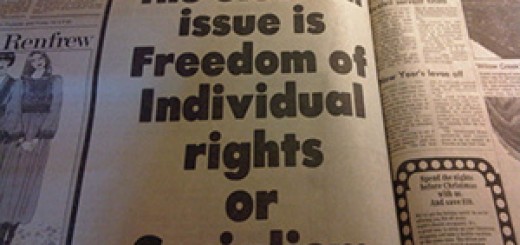Rob Ford’s Trial by Media and the Innocents Caught in the Undertow
These days, the pen (or, perhaps, the keyboard) is truly mightier than the sword. Pens shape public perception, and that power endures beyond borders and beyond lifetimes in our digital age of information.
But as the adage goes, with great power comes great responsibility. The international media frenzy surrounding the Rob Ford saga has intensified over the past week to levels never before seen by Torontonians, and the power of the pen in this sordid affair has become ever more prominent.
By now, the video of Rob Ford’s reply to allegations of sexually harassing a female staffer – which he has denied because he’s got “enough to eat at home” – has been seen around the world. Television personalities were left speechless, social media was set aflame, and U.S. talk show hosts, such as Jon Stewart on the Daily Show, concluded their Rob Ford updates last night by simply playing the clip of the Toronto mayor’s impromptu media scrum. The video itself was the punchline, and that punchline spoke volumes.
In that video clip, prior to making his now-infamous remark about needs fulfilment, Rob Ford also refutes allegations that the female “friend” he was seen consorting with on St. Patrick’s Day 2012, “Alana,” was an “escort” – an allegation that surfaced when Justice Ian Nordheimer of the Ontario Superior Court of Justice released the Toronto Police Services’ Information to Obtain a Search Warrant (ITO) in its investigation of Rob Ford’s associate Alexander Lisi. The ITO document had previously been released to the public in heavily redacted form a couple weeks earlier, but on November 13, 2013, Justice Nordheimer granted the motion by several Canadian media outlets to release the ITO with significantly fewer redactions.
THE TORONTO POLICE SERVICE’S INFORMATION TO OBTAIN
In nearly 500 pages, the ITO details the Toronto Police Service (TPS) investigation and surveillance of Mayor Ford and his friend Lisi. The investigation, dubbed Project Brazen 2, began when Lisi’s name came up during the TPS’ Project Traveller probe into local gang activity. The TPS had gathered intelligence on many of Ford’s friends and associates, but were only able to conduct interviews with a few of them. Summaries of the police’s information on these various persons of interest were contained in the ITO, and it was these related third parties that Justice Nordheimer turned his mind towards.
When the ITO was first made public on October 30, 2013, the Crown had made four types of redactions to the released document in the interests of justice: (1) edits made to protect information relating to innocent third parties, (2) edits relating to any references to the non-consensual intercepted private communications, (3) edits relating to investigative techniques, and (4) edits relating to confidential informants.
In his decision, Canadian Broadcasting Corporation and Others v HMQ, 2013 ONSC 6983, Justice Nordheimer had to consider only the first type of redaction – those relating to innocent third parties. The Crown’s authority to redact information regarding the TPS’ confidential informants and investigative techniques was not disputed by media lawyers, and Justice Nordheimer left questions about the public disclosure of wiretap information to be decided another day.
At the outset, Nordheimer J. rejected the Crown’s argument that the innocent third parties discussed in the ITO should be given notice of the media lawyers’ application to further unseal the document so that these third parties can make their own submissions to the court. Justice Nordheimer was of the position that the procedural difficulties in allowing this would be too great; 70 persons would have to be found, notified, given time to retain counsel, given access to the tightly-controlled confidential ITO, and allotted time to contest the unsealing. In His Honour’s view, not only would this “open up a Pandora’s box,” it would also undermine the very objective of confidentiality by signalling to these parties that their identities and information are contained in the ITO. In light of the immediacy of the public interest, as advocated by the media’s lawyers, these third parties would not be notified.
Moreover, Justice Nordheimer emphasized that the authority to make any edits to materials used in obtaining a judicial authorization (such as an ITO used to obtain a search warrant) rests solely with Crown prosecutors. However, Justice Nordheimer declined to declare this a hard-and-fast rule, holding that there may be “rare and exceptional” cases where other parties may have some say in the redaction process – though no such compelling argument was made in the case at bar.
The Crown argued before the Ontario Superior Court of Justice that “the lives and reputations of innocent persons will be harmed” if the first type of redaction were revealed. But the Crown failed to file any evidence that direct harm will be caused to any person, nor did the Crown specify the precise nature of that harm. Thus, Justice Nordheimer was not persuaded legally to find that this general harm was sufficient to violate the Dagenais/Mentuck test. This test, as delineated by the Supreme Court of Canada in Toronto Star Newspapers Ltd v Ontario, 2005 SCC 4, is the legal threshold for when a publication ban should be ordered by a judge. Since a ban on the publicity of judicial proceedings is in conflict with the freedom of expression as guaranteed by the Charter, such an order should be made only where:
(a) such an order is necessary in order to prevent a serious risk to the proper administration of justice because reasonably alternative measures will not prevent the risk; and
(b) the salutary effects of the publication ban outweigh the deleterious effects on the rights and interests of the parties and the public, including the effects on the right to free expression, the right of the accused to a fair and public trial, and the efficacy of the administration of justice.
Justice Nordheimer similarly dismissed the balance of the Crown’s arguments for keeping most of the redactions relating to innocent third parties by finding that the Dagenais/Mentuck test was met. He ruled that although the disclosure of the ITO to the public might cause third parties some “embarrassment,” this was not sufficient to trump the democratic principle of openness in the administration of justice. He did, however, hold that an exception to the unsealing of the innocent party redactions was to be made for information regarding personal identifiers (e.g. dates of birth, licence plate numbers, telephone numbers) and personal issues involving Mayor Ford’s wife.
Because His Honour ruled against notifying the third parties ahead of time that their identities and ties to the Mayor will soon be disclosed to the public via the ITO, the ITO in its largely-unredacted form was given to the media the same day on which his judgement was released.
HARM TO THIRD PARTIES
Certainly, most media outlets (if not all prudent ones) reporting on the Rob Ford saga prefaced their articles with caveats about how the allegations have yet to be proven in court and attributed many of the allegations to that which is merely laid out in the ITO. This may shield them from being found legally at fault for publishing defamation, but it arguably does not shield them from the call for moral responsibility as etched into popular culture by Spider Man’s Uncle Ben. In the face of the media firestorm that erupted around Rob Ford, the reputations of innocent third parties have been caught in the undertow.
Specifically, international media outlets have heavily reported that the allegations against Mayor Ford now include consorting with prostitutes. In the ITO, Mr. Isaac Ransom, former special assistant of communications to Rob Ford, told police that he believed Ms. Alana Kindree was a professional escort who knew the mayor well. She is described by Mr. Ransom in the ITO as young, petite, and blonde. Ms. Kindree was allegedly seen in the company of Mayor Ford on St. Patrick’s Day in 2012, which he was celebrating at the Bier Markt in Toronto – a celebration that allegedly involved illicit substances and that began at City Hall.
Ms. Kindree has not been charged with any criminal offences. Indeed, the ITO lists the 23-year-old’s only documented contact with the police as having been transported to a hospital by paramedics for intoxication in 2009 and, in a separate incident in the same year, getting caught smoking marijuana in a public place by security guards. She has no criminal record and was only of tangential focus in the TPS’ investigation as a potential witness.
Yet her name has now been dragged through the proverbial mud. Her father has maintained that Ms. Kindree is not in the sex trade, and her colleague is largely correct in asserting that “if you Google her name now, the first thing that comes up is ‘alleged sex worker.’”
At paragraph 26 of his decision, Justice Nordheimer held that when the innocent third parties were interviewed by the police, “each of these persons knew or ought to have known that the information that they gave to the police might eventually become public.” However, Ms. Kindree was never formally interviewed by the TPS and was likely unaware that Mr. Ransom believed she was an escort. It would be an even further stretch of the imagination to say that Ms. Kindree knew that these accusations were contained in the ITO about to be released for the world to see.
This author contends that, in the very least, Ms. Kindree may have benefitted from being notified ahead of time that accusations about her involvement as a sex trade worker were about to surface – procedural difficulties abound in the justice system, yet that is no reason to circumvent its basic goal of protecting the innocent.
Justice Nordheimer concedes in his judgement that he is relying on two basic assumptions: that the media will be responsible in what they choose to report and that the public will appreciate that these are untested and unconfirmed allegations. The legal system in Canada duly recognizes that everyone is innocent until proven guilty. But the legal threshold is quite separate and apart from the general public’s moral/emotional standard of “proof” about an individual. If the public outrage over George Zimmerman’s acquittal is any indication, this author suspects that Justice Nordheimer’s assumptions may have set the bar too high. It is now up to Ms. Kindree, ex post facto and quite likely caught by surprise, to insulate herself from the Mayor of Toronto’s firestorm that she now finds herself dragged into.








Join the conversation